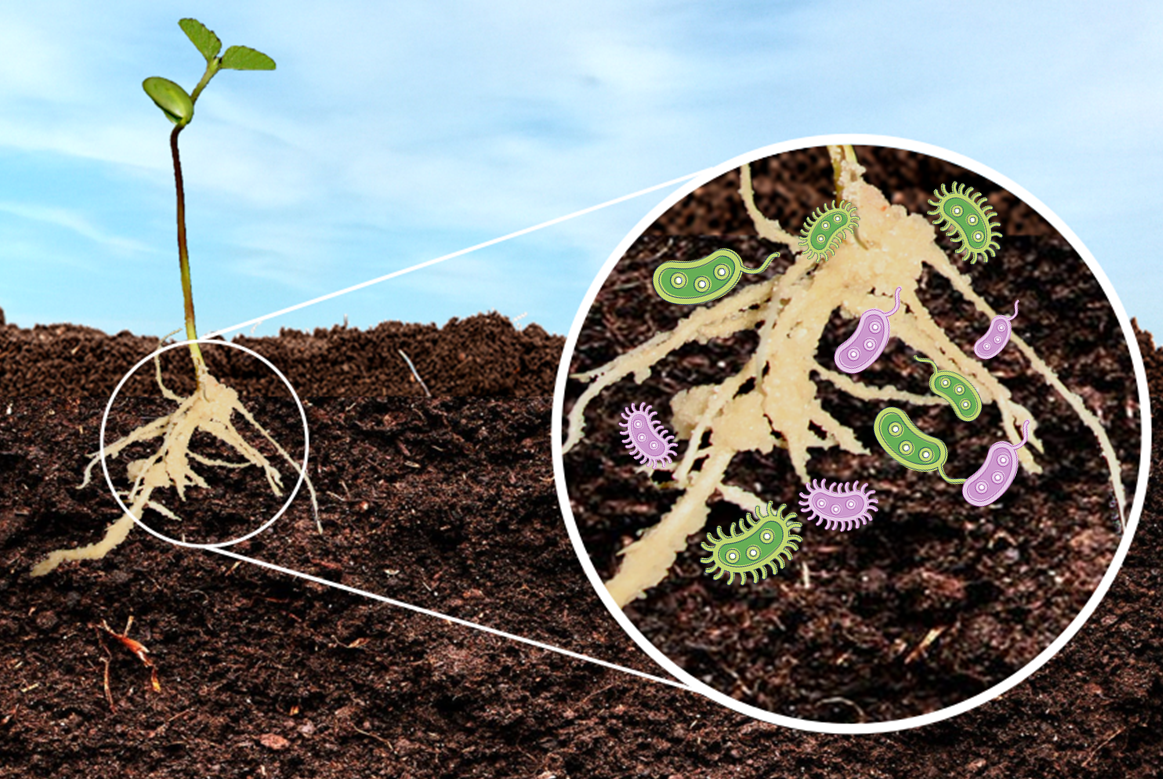At XiteBio, we care a lot about the rhizosphere. You have likely heard us using this term in previous blog posts or when answering questions about our products. But what exactly is the rhizosphere? And why is it important to your crop? This week’s edition of growing possibilities is all about the rhizosphere: what it is, why it matters, and how a healthy soil microbe population within it can make all the difference come harvest.
Let’s start from the basics: what is the rhizosphere? The rhizosphere refers to the portion of the soil immediately surrounding the roots of a plant, where the activity and diversity of soil microbes is greater than in the bulk of the soil (1). This area contains not only the soil and its related nutrients and components, but also dead plant cells, carbohydrates and other exudates released into the soil by plant roots. All of these plant growth by-products provide a wealth of nutrients for soil microorganisms, which is why so many microbes seek out and colonize plant rhizospheres (2).
The rhizosphere of a plant is a venue for many important biological processes occurring below ground, both good and bad. Plant rhizospheres are a hub for bacteria and fungi, many of them helpful to your plants, but this nutrient-rich area also makes for a preferred environment for more malicious creatures. Disease-causing pests such as Soybean Cyst Nematodes (3) and Aphanomyces fungi (4) seek out and colonise the rhizosphere of susceptible plants as well.
On the positive side, many helpful microbes have evolved alongside plants so closely that they can now form a symbiosis, a mutually beneficial living situation from which both the host plant and the soil microbe benefit. Fungi and bacteria in the rhizosphere can affect plant health and nutrient acquisition by solubilising nutrients in the soil for plant uptake, releasing phytohormones that encourage plant growth and development, and by chelating or “holding on” to nutrients in soil for plants to uptake just to name a few mechanisms. An example that legume growers are familiar with is the symbiosis between legume and nitrogen (N)-fixing bacteria. The bacteria inhabit the plant roots for a safe place to grow and reproduce and for the carbon nutrition the plant offers, and in return the plant receives N that the bacteria fix from the air around them, turning N in the air into a form that the plants can utilize (most commonly ammonia). Bacteria living in a plant’s rhizosphere that offer growth or nutrition benefits to it are termed Plant Growth Promoting Rhizobacteria (PGPR), and N-fixing bacteria in legume rhizospheres are just one example of many. PGPR can have a direct, visible effect on plant growth like in the previous example, or they may have an indirect effect via mechanisms like disease or pest control (5). Either way, PGPR can be abundant in plant rhizospheres and may work by several mechanisms to effect plant growth and development.
Hopefully you now have a better picture of what is going on below the surface of your fields during the growing season, and can appreciate the benefits and dangers that different soil inhabitants can present. Inoculants are a well-known and necessary resource for legume growers, but as the number of growers trying other PGPR rises, so should the Ag community’s knowledge of the powers of microbes living in the rhizosphere.
To learn more about how PGPR and other rhizosphere inhabitants can help your crops, check out the previous posts on our blog, or head to xitebio.ca to discover more about our PGPR biologicals and inoculants.
References:
1) Gregorich, E.G., Turchenek, L.W., Carter, M.R., Angers, D.A. 2002. Soil and Environmental Science Dictionary. Boca Raton, London, New York, Washington D.C.: CRC Press. P. 302.
2) Duponnois, R. 2006. Mycorrhiza Helper Bacteria: Their Ecological Impact in Symbiosis in Handbook of Microbial Biofertilizers. New York, London, Oxford: Food Products Press. P. 117-130.
3) Masonbrink, R., Maier, T. R., Muppirala, U., Seetharam, A. S., Lord, E., Juvale, P. S., … Baum, T. J. (2019). The genome of the soybean cyst nematode (Heterodera glycines) reveals complex patterns of duplications involved in the evolution of parasitism genes. BMC Genomics, 20(1), 1–14. https://doi.org/10.1186/s12864-019-5485-8
4) Wu, L., Chang, K. F., Conner, R. L., Strelkov, S., Fredua-Agyeman, R., Hwang, S. F., & Feindel, D. (2018). Aphanomyces euteiches: A Threat to Canadian Field Pea Production. Engineering, 4(4), 542–551. https://doi.org/10.1016/j.eng.2018.07.006
5) Banerjee, M.R., Yesmin, L., Vessey, J.L. 2006. Plant-Growth-Promoting-Rhizobacteria As Biofertilizers and Biopesticides in Handbook of Microbial Biofertilizers. New York, London, Oxford: Food Products Press. P. 137-181.


